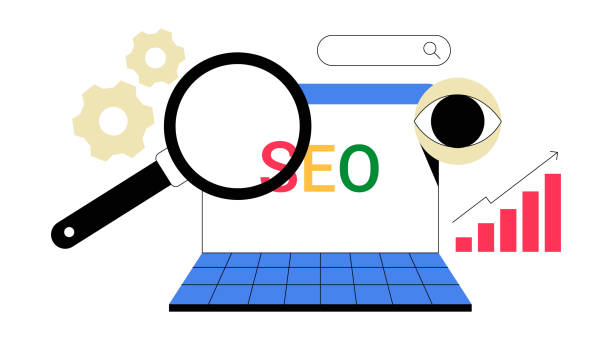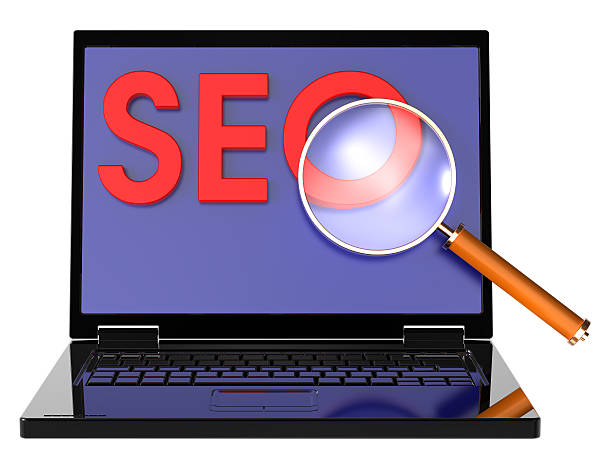The Importance of SEO and Its Place on the Web

In today’s digital world, where the competition for visibility has peaked, SEO or Search Engine Optimization, has become more vital than ever.
This educational and complex process helps businesses and individuals optimize their websites for higher ranking in search engine results like Google.
The main goal of SEO is to increase organic (natural) traffic to a website, meaning users find your website through Google search and not through paid advertisements.
The higher your website’s ranking, the more likely it is to be seen and attract more customers.
In fact, SEO is the key to visibility and success in the online market.
Today, many users directly turn to search engines to find products, services, or information.
Therefore, if your website does not appear on the first pages of search results, it will be virtually invisible to a large portion of your target audience.
This process is not limited to keyword selection but also includes improving user experience, site loading speed, content structure, and site authority.
A deep understanding of how Google’s algorithms and other search engines work is essential for any successful SEO strategy.
This process requires continuous analysis and updating strategies according to algorithm changes.
Are you tired of your company’s website not meeting your expectations? With Rasaweb, design a professional website that truly represents your business.
✅ Increase new customer acquisition and sales leads
✅ Boost your brand’s credibility and trust among your audience
⚡ Get a free website design consultation!
On-Page SEO: The Cornerstone of Visibility

On-Page SEO refers to a set of techniques implemented within the website itself to optimize it for search engines and users.
This part of SEO involves optimizing various elements that are directly under the website owner’s control.
The most important of these elements include Title Tags and Meta Descriptions, which provide the first impression of the page’s content to search engines and users.
Proper use of keywords in these sections helps search engines better understand the page’s topic.
Optimizing headings (H1, H2, H3) also plays a key role in content organization and improving readability.
High-quality content relevant to target keywords is the backbone of on-page SEO.
This content should be comprehensive, useful, and engaging for the user.
Furthermore, the explanatory nature of the content and its ability to answer users’ informational needs are of high importance.
Optimizing images by using appropriate alt tags and compressing them to reduce size helps improve site speed and image understanding by search engines.
Page URL structure should be short, readable, and include main keywords.
Also, internal linking between different pages of the website helps distribute page authority and improve user navigation.
All these factors together signal to search engines that your website is credible and relevant to user searches.
This part of SEO provides a strong foundation for any successful SEO strategy.
Off-Page SEO: The Bridge to the Outside World

Off-Page SEO refers to all activities performed outside your website that help increase its authority and ranking in search results.
The most important and impactful factor in off-page SEO is Backlinks.
A backlink is a link from another website to your website.
Search engines consider backlinks as a vote of confidence from other websites.
The higher the number and quality of backlinks, the more authoritative your website appears to search engines.
However, quality takes precedence over quantity; a backlink from authoritative and relevant websites is far more valuable than low-quality links.
Building backlinks requires specialized strategies, including producing valuable content that naturally attracts links, guest blogging on other blogs, and participating in reputable forums and directories.
| Feature | Quality Backlinks (Good Backlinks) | Poor Backlinks (Bad Backlinks) |
|---|---|---|
| Link Source | From reputable, relevant, and high-authority websites | From spammy, unreliable, irrelevant, or low-quality content websites |
| Topical Relevance | Links from content directly related to your content. | Links from completely irrelevant pages or sites |
| Anchor Text | Natural, diverse, and relevant anchor text to target keywords | Spammy, generic anchor text (like “click here”) or excessive use of a single keyword |
| Link Purpose | Providing added value to the user and referencing a useful source | Solely for manipulating search engine rankings |
| Other Factors | Located within the main content of the page (contextual link) | Link in footer, sidebar, or spam comments |
In addition to backlinks, social media signals also play a role in off-page SEO; although not direct ranking factors, they can help increase visibility and traffic to the website.
Active presence on social platforms and content sharing can lead to increased brand awareness and ultimately, backlink acquisition.
Local SEO is also vital for businesses looking to attract customers in a specific geographical area, and it includes optimizing business listings on Google Maps and local directories.
Managing online reviews and receiving positive customer feedback also boosts your online credibility and helps improve SEO.
These activities collectively significantly strengthen domain authority and improve the website’s position in search results.
Technical SEO: The Infrastructure for Website Stability

Technical SEO refers to the process of optimizing the technical aspects of a website to help search engines better crawl and index it.
These aspects also directly impact user experience.
Site loading speed is one of the most important technical SEO factors; slow websites not only provide a poor user experience but are also ranked lower by search engines.
Tools like Google PageSpeed Insights can help identify speed issues.
Mobile-friendliness is also vital, as most searches today are performed via mobile devices, and Google prioritizes mobile-friendly sites.
Ensuring website Crawlability and Indexability through the robots.txt file and XML Sitemap is essential.
These files guide search engines on which pages to crawl and index.
Implementing the HTTPS protocol for website and user data security is also considered a ranking factor.
Using Schema Markup helps search engines better understand website content and display it as Rich Snippets in search results.
Managing 404 errors and 301 redirects is also important to prevent crawling issues.
Technical SEO acts as a strong foundation for all SEO efforts, and neglecting it can seriously harm the overall performance of the website in search engines.
Still don’t have a company website and missing out on online opportunities? With professional corporate website design by Rasaweb,
✅ Double your business credibility
✅ Attract new customers
⚡ Get a free consultation for your corporate website!
Keyword Research: The Pulse of Every SEO Campaign

Keyword research is the heart of every successful SEO strategy.
This process involves finding the words and phrases that users employ in search engines to locate your information, products, or services.
The main goal is to identify keywords with high search volume and suitable competition so you can rank effectively.
Keywords can be divided into two main categories: Short-tail Keywords, which are usually one to two words (like “SEO”), and Long-tail Keywords, which consist of three or more words (like “best SEO company in Tehran”).
Longer keywords usually have lower search volume but offer higher conversion rates, as the user’s intent is more specific.
In the analytical process of keyword research, understanding users’ Search Intent is crucial; is the user looking for information, intending to buy, or seeking directions? Tools like Google Keyword Planner, Ahrefs, and Semrush help you discover relevant keywords and evaluate their search volume and competition difficulty.
Also, analyzing competitor keywords and finding Niche Opportunities can give you a competitive advantage.
A precise educational strategy in keyword research helps you create content that exactly matches your target audience’s needs and questions, thereby attracting more relevant and higher-quality traffic to your website.
This essential step paves the way for success in SEO.
Content: The Undisputed King in SEO

Content is a vital element and the undisputed king in the world of SEO.
Without high-quality and relevant content, all technical and off-page SEO efforts will be fruitless.
Search engines aim to provide the best and most relevant answers to user queries, and this answer is presented in the form of content.
Quality content must be original, comprehensive, accurate, and most importantly, valuable to the user.
This includes blog posts, product pages, videos, infographics, podcasts, and any other format that conveys information to the audience.
For success in SEO, content must not only be optimized for keywords, but also be written in a way that creates thought-provoking content and encourages user interaction.
Engaging content can also increase user retention rates on the site and send positive signals to search engines.
The E-A-T principle (Expertise, Authoritativeness, Trustworthiness), which stands for expertise, authority, and trustworthiness, has gained increasing importance in Google’s content ranking.
This means your content should be written by experts and have credible sources.
Continuously updating old content and adding new and relevant information can also help maintain rankings and attract new traffic.
Ultimately, content creation with the goal of user attraction and satisfaction is the most important long-term strategy in the world of SEO.
Measuring SEO Performance and Analyzing Results

After implementing SEO strategies, measuring performance and analyzing results is crucial for understanding the extent of success and identifying opportunities for improvement.
This process allows you to evaluate your Return on Investment (ROI) and make data-driven decisions.
Key tools for this purpose are Google Analytics and Google Search Console.
Google Analytics provides precise information about website traffic, user behavior (such as bounce rate, pages visited, time spent on site), and conversion rates.
Google Search Console also offers direct insights from Google regarding website performance in search results, including ranked keywords, crawl errors, and incoming links.
| Metric | Description | Importance for SEO |
|---|---|---|
| Organic Traffic | The number of visitors coming through natural search engine results. | The main indicator of SEO success. Shows the effectiveness of optimization strategies. |
| Keyword Rankings | The position of website pages for specific keywords in search results. | Direct evaluation of progress in target keyword competition. |
| Bounce Rate | The percentage of visitors who view only one page and leave the site without interaction. | A high bounce rate can indicate irrelevant content or a poor user experience. |
| Conversion Rate | The percentage of visitors who complete a desired action (e.g., purchase, registration). | Indicates the effectiveness of SEO traffic in achieving business goals. |
| Time on Page | The average time visitors spend on a particular page. | Longer duration indicates engaging content relevant to user needs. |
Key Performance Indicators (KPIs) include organic traffic, keyword rankings, bounce rate, and conversion rate.
Conducting A/B tests to improve various page elements and digital marketing can help further optimization.
Preparing regular and analytical reports from this data helps you identify positive and negative trends and adjust your strategies based on the latest updates.
Continuous and data-driven optimization is one of the main pillars of success in SEO.
This process ensures that your SEO efforts are always on the right track and lead to the best possible results.
The Future of SEO: Artificial Intelligence and User Experience

The future of SEO is strongly intertwined with advancements in Artificial Intelligence (AI) and an increasing focus on User Experience (UX).
Google’s algorithms, such as RankBrain and BERT, use AI to better understand user search intent and provide more accurate results.
This means that merely using keywords is no longer sufficient; content must truly answer user questions and fulfill their needs.
The specialization of SEO in new areas like Voice Search is also growing.
With the increasing popularity of voice assistants like Siri and Google Assistant, optimizing for long, conversational questions that users ask verbally becomes important.
Video SEO has also become a crucial area given the growth of platforms like YouTube and TikTok; optimizing video titles, descriptions, tags, and captions is very important for visibility in search results.
Core Web Vitals, a set of user experience-related factors (such as loading speed, interactivity, and visual stability), have now become primary ranking factors.
This means that websites must have flawless technical performance to achieve good rankings in search results.
Ultimately, focusing on a comprehensive user experience, which means providing a fast, secure, accessible website with quality content that meets user needs, will be the main direction for the future of Search Engine Optimization.
Does your company’s website perform as befits your brand? In today’s competitive world, your website is your most important online tool. Rasaweb, specializing in professional corporate website design, helps you to:
✅ Earn customer credibility and trust
✅ Convert website visitors into customers
⚡ Get a free consultation for your corporate website!
Common SEO Mistakes and Avoidance Strategies

On the path to Search Engine Optimization, many websites make mistakes that can seriously harm their position in search results.
One of the most common mistakes is Keyword Stuffing.
Attempting to unnaturally insert too many keywords into content not only sends negative signals to search engines but also disrupts the user experience.
Google easily identifies these Black Hat SEO techniques and penalizes the website.
Duplicate Content is another common problem.
The presence of identical or very similar content on different pages of a website or even on other websites can confuse search engines and harm your ranking.
The guidance is to always produce unique and valuable content.
Ignoring mobile optimization in today’s world, where most searches are conducted via mobile, is a grave mistake.
Your website must be fully responsive and optimized for mobile devices.
Poor site structure and complex navigation can also harm site crawling and indexing and confuse users.
The website should have a logical, hierarchical, and easy navigation structure.
Failure to use XML Sitemap and robots.txt file can also prevent search engines from fully crawling the website.
Furthermore, purchasing low-quality backlinks or participating in link-building networks that violate Google’s policies leads to severe penalties.
To avoid these mistakes and ensure success in SEO, it is necessary to always adhere to best practices (White Hat SEO) and stay updated with the latest changes in search engine algorithms.
SEO: A Big Step Towards Sustainable Success

In conclusion, it can be said that SEO is not just a set of techniques, but a long-term and continuous strategy for sustainable success in the online space.
This process requires patience, continuous analysis, and the ability to adapt to changes in search engine algorithms.
Success in Search Engine Optimization means creating an excellent user experience, providing high-quality and valuable content, and building credibility in the web world.
Search engines are constantly evolving to provide the best and most relevant results to users, so websites that focus on quality principles and user needs will always be successful in the long run.
Continuous optimization, performance monitoring, and strategy updates based on analytical data are among the key factors in maintaining and improving a website’s position in search results.
Investing in SEO is investing in the future of your online business, as it leads to organic traffic, increased brand awareness, and ultimately, sustainable growth.
In today’s competitive world, a strong presence in search results is no longer an option but a necessity for any business that wants to succeed in the digital space.
Frequently Asked Questions
| Question | Answer |
|---|---|
| What is SEO? | SEO, or Search Engine Optimization, is a process for increasing the quality and quantity of website traffic by improving the site’s ranking in natural (organic) search engine results like Google. |
| What are the main types of SEO? | SEO is divided into three main categories: On-Page SEO, Off-Page SEO, and Technical SEO. |
| What does On-Page SEO include? | On-Page SEO includes optimizing elements within the website, such as keywords, Title Tags, Meta Descriptions, content, URL structure, images, and internal links. |
| What is Off-Page SEO? | Off-Page SEO refers to activities outside the website that help improve its ranking, such as Backlink Building, social media marketing, and Brand Mentions. |
| What is Technical SEO? | Technical SEO deals with optimizing the technical aspects of a website to help it be better crawled and indexed by search engines. This includes site speed, mobile-friendliness, site structure, Sitemaps, and the Robots.txt file. |
| What role do Keywords play in SEO? | Keywords are phrases that users enter into search engines. Proper and targeted use of relevant keywords in content and site elements helps search engines understand your page’s topic and display it for relevant searches. |
| What is a Backlink and why is it important? | A backlink, or inbound link, is a link from one website to another. Backlinks act as a “vote of confidence” from other sites for search engines and play a significant role in site authority and ranking improvement, especially if they are from reputable sites. |
| What impact does quality content have on SEO? | Quality, relevant, comprehensive, and unique content not only attracts and retains users but also shows search engines that your page is valuable. This helps improve ranking, reduce Bounce Rate, and increase user time on site. |
| Why is site loading speed important for SEO? | Site loading speed is an important ranking factor for Google. Faster sites provide a better user experience, have lower bounce rates, and are preferred by search engines. |
| Is SEO a one-time process? | No, SEO is an ongoing and long-term process. Search engine algorithms are constantly changing, competition is increasing, and site content also needs updating. Therefore, SEO requires continuous monitoring, analysis, and optimization. |
And other services of Rasaweb Advertising Agency in the field of advertising
Smart Marketplace: A fast and efficient solution for increasing website traffic with a focus on intelligent data analysis.
Smart Conversion Rate Optimization: An innovative service for increasing sales through Google Ads management.
Smart Advertorial: A creative platform for improving customer behavior analysis with precise audience targeting.
Smart Custom Software: A specialized service for growing sales based on Google Ads management.
Smart Brand Identity: Designed for businesses seeking online growth through the use of real data.
And over hundreds of other services in the field of internet advertising, advertising consultation, and organizational solutions
Internet Advertising | Advertising Strategy | Advertorial
Resources
- SEO Training: What is SEO?
- What is SEO and how can it grow your business?
- What is SEO Training? (Zero to Hundred) + Introduction of Reputable Sources
- What is SEO? Comprehensive Training with Website SEO Tips (2023 Update)
? To elevate your business in the digital space and reach the peaks of success, experience custom website design and comprehensive digital marketing services with Rasaweb Afarin.
📍 Tehran, Mirdamad Street, next to Central Bank, Southern Kazeroun Alley, Ramin Alley, No. 6



